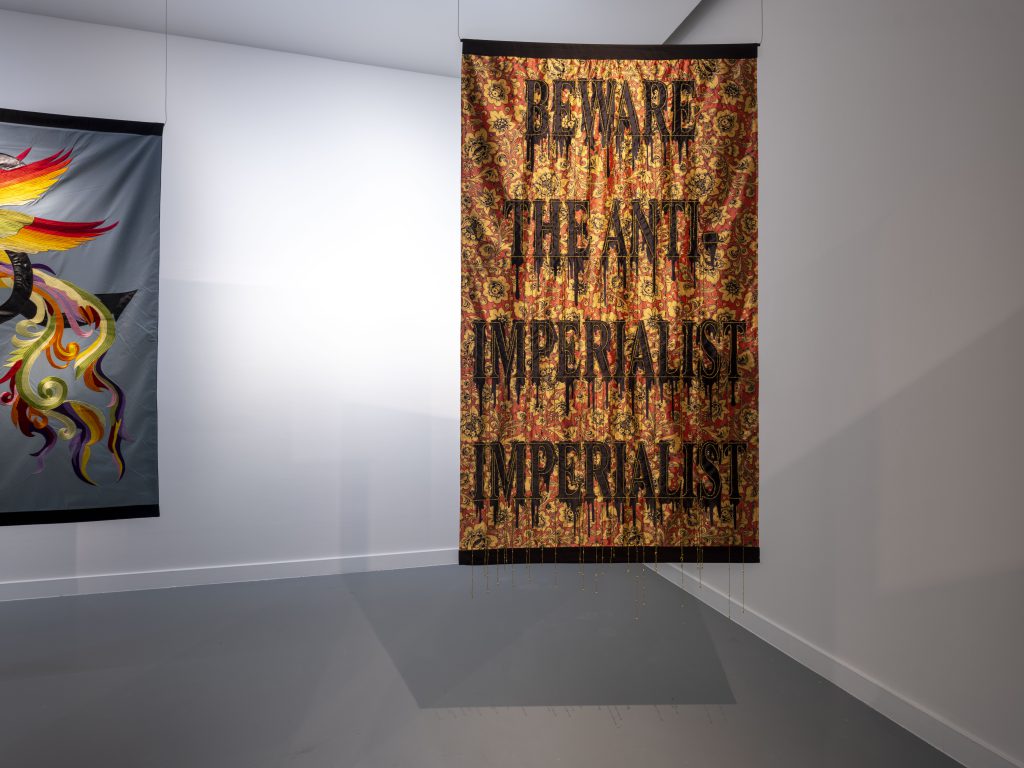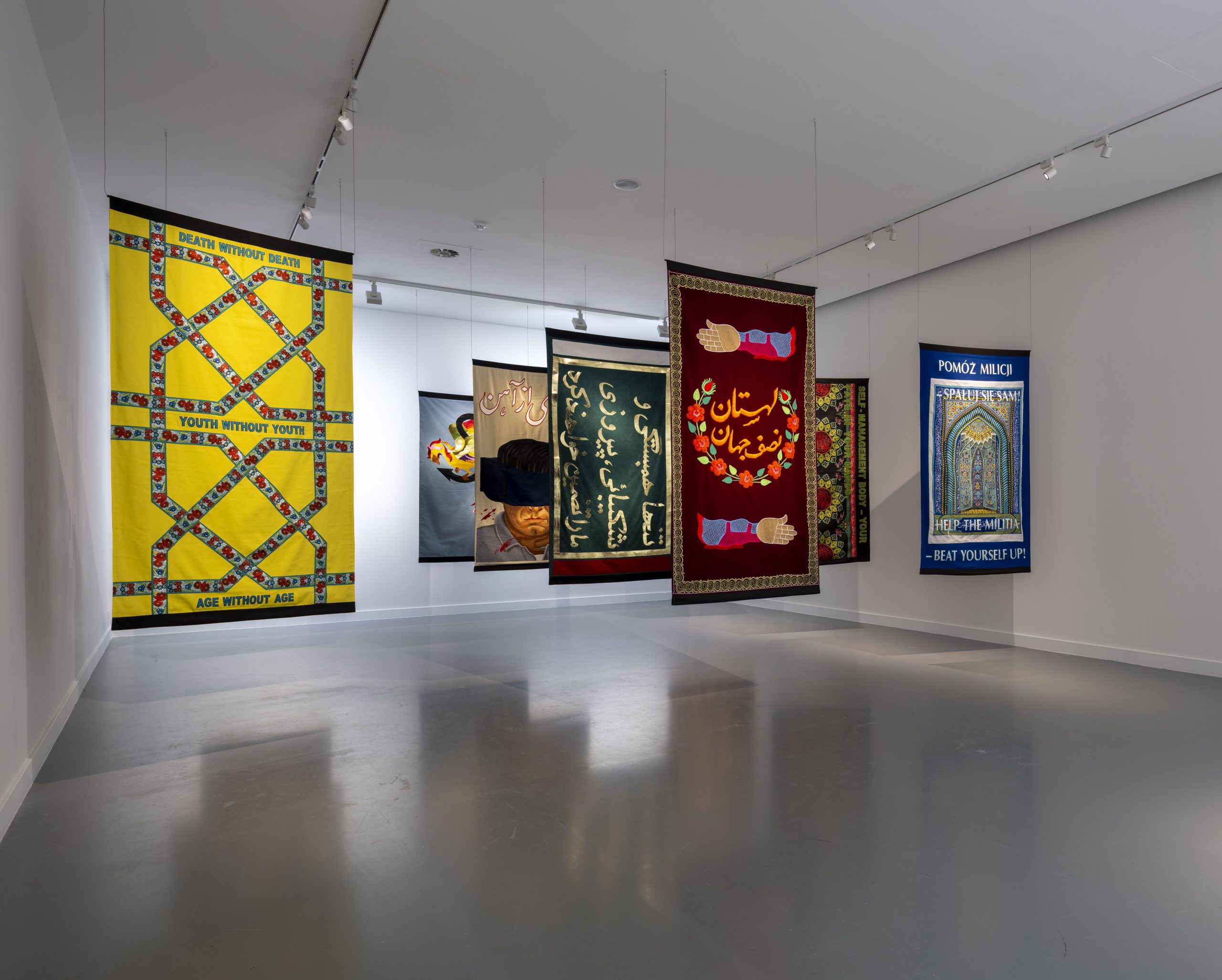Berlin-based Slavs and Tatars present an unlikely but thought-provoking cocktail in Friendship of Nations: Polish Shi’ite Showbiz at Museum of Contemporary Art Antwerp.
Friendship of Nations is an attempt by Slavs and Tatars to usurp the world of its political hangovers. The politics of Iran, which has for some months now ruptured into foment, seems in stark contrast to Poland’s lesser ills. Yet these were countries that, decades and worlds apart, were once involved in seismic political and social shifts that have tempted the artist, and designer, Payam Sharifi and Kasia Korczak respectively, to introduce them as allies in another world. History rewritten, and with Islam (and migration) now an issue in Poland, new synchronicities arise.
Yet the intellectual and visual premise of Iran and Poland feeling an incredible kinship proves incredibly problematic, poisonous even. Just inside Antwerp’s Museum of Contemporary Art, the one-room exhibition comprises acutely coloured banners that in their day hailed the Iranian Revolution during the late 1970s, and with the same urgency, ushered communism out of Poland in the 1980s, with the overthrow of the Imperial Shah in Iran and the social reforms of Solidarność (Solidarity) in the former Eastern Bloc nation. The title Friendship of Nations: Polish Shi’ite Showbiz reads like a mangling of modern history and is introduced as the newest statement phrase, intended to reintroduce these fanatical fabrics, that have, for the duration of the exhibition, these two countries coming together as creative confederates.
Crisp, clean banners, that for all their re-appropriation lack their demonstrative demands, having been staged as historical or decorative adornments. For Slavs and Tatars, if the political interests of these two countries are entirely different, then what they introduce is the commonality of man. That people the world over, oppressed, empowered, politically charged, are all seeking something better. and it could be that the creative act is in the action of thinking beyond politics for a human history.

Image courtesy of the artists and the Museum of Contemporary Art Antwerp
Visually, hanging away from the entrance and to the back of the exhibition space, curated as a collection of billboards, the intention appears to be that the signs intermingle, supporting one another’s rhetoric, even if they are worlds apart. Without an audience, away from the demonstration lines and the illegal gatherings, they appear to enjoy an honourable sleep, selling us a romantic idea of the struggle that shows no evidence of the dirt or blood and tears. On the opposite side of the room is a large wooden lounger, carpeted and covered in copies of various politically inspired, roughly reproduced, pamphlets, that page for page have turned individuals and events into comic strips, propagandised tittle-tattle. Sit, lay down if you need to, look and think, before deciding if Poland and Iran’s struggles were the same. ‘Beware the Anti-Imperialist Imperialist’, ‘Death without Death’, ‘Youth with Youth’, are some of the battle cries on these stretches of fabric which, without their wording, might appear like tablecloths, and transforms them into protest banners – language able to introduce a new dimension to the visual that draws us back to reality.
This is an exhibition and set of ideas that aren’t easily understood. The choice of banners tries to profit from their original political urgency, which in hindsight, and for all their idealism, has seen so many consequential changes in both countries, unexpected and enlightening at the same time. Yet everything returns to the people, and the craftsmanship of these banners, the involvement of Iranian tailors and seamstresses from Poland, sees art as able to introduce a new vision of events that exploded onto the global landscape in the 1970s and 80s in a way that made it impossible to own them. With those revolutions since morphed or put-to-bed, these replica banners become something else entirely, wanting to be re-activated by a new generation of post-modern protestors.
For the initial problematics of the exhibition, it proves compelling to be given the tools – the banners and the books – that enable enlightenment to the idea that protest, reaction and revolt are human conditions, irrespective of aspirations and political alliances. They exist as a form of social communication, and the idea of having a voice is to be heard and a universal urge, beyond whatever commonalities might exist between Iran and Poland. So the distance between this exhibition’s countries, the black-and-white difference of their politics, has something to it, as the Berlin collective cut through geographies, pin politics together, and apply a post-modernist approach to explaining the cause and effect of ego and self-interests. Grappling with so many critical and cultural changes, Slavs and Tatars see the heavy events of history as poetic licence to throw pop culture at politics, mythology at murder, to create a collective conscience for the crimes of corrupted ideals. That certainly offers something interesting.
Slavs and Tatar’s Friendship of Nations: Polish’ Shi’te Showbiz is on display as a collection presentation donated to the M HKA by Christian Kaspar Schwarm.
Friendship of Nations: Polish Shi’ite Showbiz runs until 30 April 2023



